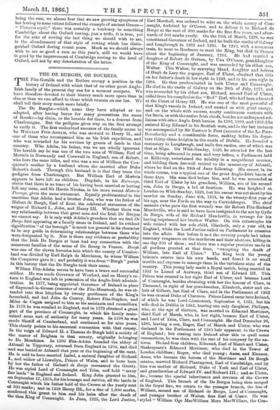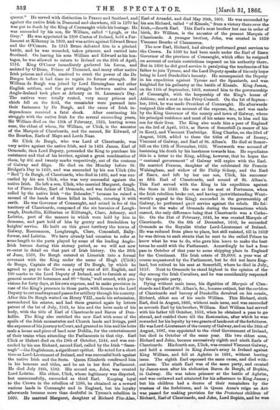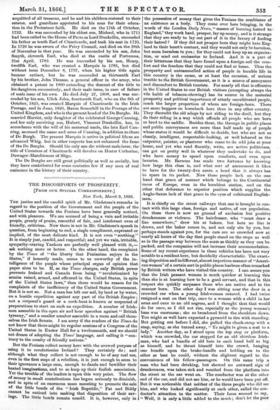THE DE BURGHS, OR BOURKE& ITHE Fitz-Geralds and the Butlers
occupy a position in the history of Ireland with which that of no other great Anglo-
Irish family of the present day can for a moment compete. We have therefore devoted to their history muck more space than is ,due or than we can afford to those which remain on our list. We :shall tell their story much more briefly.
The De Burghs—which name they have adopted or re-
:adopted, after having borne for many generations the name of Bourke—lay claim, or the heralds for them, to a descent from Charlemagne. But the pedigree gives way on the first attempt -to verify it. The first undoubted ancestor of the family seems to be WILLIAM Frrz-ADEL.v, who was steward to Henry IL, and one of those who accompanied him on his Irish expedition, and who was rewarded, for his services by grants of lands in that country. Who Adelm, his father, was we are wholly ignorant. The heralds say he was one of the two sons of William, Earl of Mortein in Normandy and Cornwall in England, son of Robert, -who bore the same titles, and who was a son of William the Con- • queror's mother by a husband whom she married after Duke Robert's death. Through this husband it is that they trace the ipedigree from Charlemagne. But William Earl of Mortein :appears to have left no children. Dugdale, in his Baronage, -states that there is no trace of his having been married or having left any issue, and Sir Harris Nicolas, in his more recent Historic Peerage, gives the same statement. Equally problematical is the :assertion that Adehn had a brother John, who was the father of Hubert de Burgh, Earl of Kent, the celebrated statesman of the weigns of Richard I., John, and Henry III. Whether there was any relationship between that great man and the Irish De Burgos we cannot say. It is only with Adelm's grandson that we find De Burgo first appearing as a family name in Ireland, and its evident :siguification " of the borough" is much too general in its character to be any guide in determining relationships between those who were designated by it. Nor is there any evidence or probability that the Irish De Burgos at least had any connection with the numerous families of the name of De Bourg in. France. Burgli was one of the eleven. baronies into which the county of Cumber- land was divided by Earl Ralph de Meschines, to whom William the Conqueror gave it ; and probably it was from " Burgh" parish du this barony that the De Burghs took their name.
William Fitz-Adelm seems to have been a brave and successful
moldier. He was made Governor of Wexford, and on Henry's re- turn to England was left in possession of the Anglo-Irish adminis- tration. In 1177, being appointed Governor of Ireland in place .of Raymond-le-Grosse (ancester of the Fitz-Maurices), he was at- tended into that kingdom by twenty gentlemen of the King's imusehold, and had John de Courcy, Robert Fitz-Stephen, and Miles de Cogan assigned to him as his assistants and councillors. la 1178 he was recalled to England, and in 1179. obtained a great part of the province of Connaught, in which his family main- tained some sort of authority for many years. In 1198 he was made Sheriff of Cumberland, and continued so for nine years. This clearly points to his ancestral connection with that county. In the reign of Edward IL a Thomas de Burgh held a moiety of the manor of Brigham in that county, originally belonging to De Meachines. In 1200 Fitz-Adelin founded the abbey of Athassil in Tipperary, returned from England in 1204, and died and was buried at Athassil that year or the beginning of the next. Ile is said to have married Isabel, a natural daughter of Richard L, and widow of Llewellyn, Prince of Wales, and to have been by her the father of Richard de Burge (surnamed the Great).
He was styled Lord of Connaught and Trim, and held "many
fair lands " in England and Ireland. King John granted to him, on September 17,1215, for his homage and service, all the lands in Connaught which his father held of the Crown at the yearly rent of 300 marks ; and in 1218 Henry III., for a fine of 1,000 marks, confirmed this grant to him and his heirs after the death of the then King of Connaught. In June, 1225, the Lord Justice,
queror." He served with distinction in France and Scotland, and against the native Irish in Desmond and elsewhere, till in 1270 he was put to death by the King of Connaught while his hostage. He was succeeded by his son, Sir William, called " Lyegh, or the Grey." He was appointed in 1308 Custos of Ireland, held a Par- liament at Kilkenny in 1309, and was active against Edward Bruce and the O'Conors. In 1315 Bruce defeated him in a pitched battle, and he was wounded, taken prisoner, and carried into Scotland. On leaving his sons William and Edward as his hos- tages, he was allowed to return to Ireland on the 25th of April, 1316. King O'Conor immediately gathered his forces, and assisted by O'Brien, Prince of Thomond, and many other native Irish princes and chiefs, resolved to crush the power of the De Burgos before it had time to regain its former strength. Sir William de Burgh was joined by Lord Birmingham and other English settlers, and the great struggle between native and Anglo-Ireland took place at Athenry on St. Laurence's Day. The natives were totally routed, very many princes and chiefs fell on the field, the remainder were pursued into their fastnesses by De Burgh, and the cause of Irish in- dependence received a fatal shock. After continuing his struggle with the native Irish for the several succeeding years, Sir William died on the 13th of February, 1325, leaving seven sons, the eldest of whom, Sir William, or Ulick, is the ancestor of the Marquis of Clanricarde, and the second, Sir Edward, of the Bourkes, Earls of Mayo and Lords Naas.
Sir Ulick de Burgh, who was Lord of Clanricarde, was very active against the native Irish, and in 1424 James, Earl of Ormonde, then Lord Deputy, persuaded the King to purchase his assistance and that of his brother, against a great combination of them, by 401. and twenty marks respectively, out of the customs of Galway and Sligo. He died on the Monday before St. Bridget's Day in 1429, and was succeeded by his son Ulick (the " Red ") de Burgh, of Clanricarde, who died in 1485, and was suc- ceeded by his son Ulick, who was very successful against the native Irish. He left a son, Ulick, who married Margaret, daugh- ter of Pierce Butler, Earl of Ormonde, and was father of Ulick, called by the native Irish "the Beheader," because he raised a mound of the heads of those killed in battle, covering it with earth. He was Governor of Connaught, and seized in fee of the territory of Clanricarde, composed of the six baronies of Lough- reagh, Dunkellin, Killtaraan or Killtaragh, Clare, Athenry, and Leitrim, part of the manors in which were held by him in demesne, and part held of him by gentry and freeholders by knights' service. He built on this great territory the towns of Galway, Roscommon, Loughreagh, Clare, Concashell, Bally- forwar, and Leitrim. We have already had occasion to refer at some length to the parts played by some of the leading Anglo- Irish barons during this stormy period, so we will not now re-enter in detail on that part of Irish history. On the 28th of June, 1538, De Burgh entered at Limerick into a formal covenant with the King under the name of Hugh (Ulick) de Burgo, Captain of the county of De Burgh, by which he agreed to pay to the Crown a yearly rent of 401. English, and 100 marks to the Lord Deputy of Ireland, and to furnish at any general muster 20 horsemen and 80 " Scots," well armed, with pro- visions for forty days, at his own expense, and to make provision in case of the King's presence in those parts, with license to the Lord Deputy to cut roadways and passes for artillery through his country. After this De Burgh waited on Henry VIII., made his submission, surrendered his estates, and had them granted again by letters patent of the 1st of July, 1543, to him and the heirs male of his body, with the title of Earl of Clanricarde and Baron of Dun- kellin. The King also enriched the new Earl with some of the spoils of the Irish monasteries and Church lands and livings, paid the expenses of his journey to Court, and granted to him and his heirs male a house and piece of land near Dublin, for the entertainment of their trains when attending the Parliaments in that city. Earl Ulick or Hubert died on the 19th of October, 1544, and was suc- ceeded by his son Richard, second Earl, called by the Irish " Sawa- nagh"—the Englishman, a significant epithet. He acted for a short time as Lord-Lieutenant of Ireland, and was successful both against the native Irish and the Soots. Queen Elizabeth confirmed him in his honours and titles, and he sat in her first Parliament. He died July 24th, 1582. His second son, John, was created Lord Leitrim. His eldest, Ulick, whose legitimacy was disputed, but unsuccessfully, succeeded as third EarL Keeping loyal to the Crown in the rebellion of 1586, he obtained as a reward various lands in Connaught and in England, but his loyalty afterwards became more than doubtful in Tyrone's rebellion in 1600. He married Margaret, daughter of Richard Fitz-Alan, Earl of Arundel, and died May 20th, 1601. He was succeeded by his son Richard, called " of Kinsale," from a victory there over the Irish,—fourth Earl. This Earl's next brother but one in order of birth, Sir William, is the ancestor of the present Marquis of Clanricarde. A younger brother, John, was created in 1629$ Viscount Bourke of Clanmorres.
The new Earl, Richard, had already performed great services to. the Crown. In 1599 he had been made under the Earl of Esser Governor of the province of Connaught, which office he resigned on account of certain restrictions imposed on his authority there_ But in 1600 he did good service in paralyzing the tendencies of his father to join Tyrone, and the Lord Deputy speaks of his only hope being in Lord Dunkellin's honesty. He accompanied the Deputy- in his expedition against Tyrone and the Spaniards, and was knighted for his gallantry at the battle of Kinsale. King James,. on the 11th of September, 1603, restored him to the governorship. of Connaught, with the keepership of the King's house of Athlone, and a seat in the Privy Council. On the 1st of Septem- ber, 1604, he was made President of Connaught. He afterwards: resigned this office on account of the expense, &c., and was made• by the King Governor of the county and town of Galway, where his principal residence and most of his estate were, to him and his
• for their lives. The King also made him a peer of England'
on the 3rd of April, 1614, as Baron of Somerhill (a manor of his in Kent), and Viscount Tunbridge. King Charles, on the 23rd of' August, 1628, added to these the titles of Baron of Imany, Viscount of Galway, and Earl of St. Alban's. He died at Somer- hill on the 12th of November, 1635. Wentworth was accused of hastening his death by his harshness towards him. He repudiates: this in a letter to the King, adding, however, that he hopes the: " cantonal government" of Galway will expire with the Earl_ Hemarried Frances, daughter of the celebrated Sir Francis Walsingham, and widow of Sir Philip Sidney, and the Earl of Essex, and left by her one son, Ulick, his successor- as fifth Earl of Clanricarde, and second of St. Alban's.. This Earl served with the King in his expedition against: the Scots in 1640. He was at his seat at Portumna, wheix the Irish rebellion broke out, and having (notwithstanding Went- worth's appeal to the King) succeeded in the governorship of Galway, he performed good service against the rebels. He foil- lowed in the wake of Ormonde during the transactions which- ensued, the only difference being that Clanricarde was a Catho- lic. On the 21st of February, 1645, he was created Marquis of Clanricarde. On the 6th of December, 1650, he succeeded Ormonde as the Royalist titular Lord-Lieutenant of Ireland. He was reduced from place to place, but still resisted, till in 1652 he was driven to such straits that he sent to the exiled Prince to. know what he was to do, who gave him leave to make the beat- • terms he could with the Parliament. Accordingly he had a free- pass in October of that year to some shipping place in England' for the Continent. His Irish estate of 29,0001. a year was of course sequestered by the Parliament, but he did not leave Eng- land, but retired to his seat at Somerhill, where he died in July„ 1657. Next to Ormonde he stood highest in the opinion of the day among the Irish Cavaliers, and he was considerably respected by the opposite party.
Dying without male issue, his dignities of Marquis of Clan- ricarde and Earl of St. Alban's, &c., became extinct, but the earldom of Clanricarde and barony of Dunkellin devolved on his cousin,, Richard, eldest son of his uncle William. This Richard, sixth Earl, died in August, 1666, without male issue, and was succeeded' as seventh Earl by his brother, William. Earl William had served' with his father till October, 1652, when he obtained a pass to go• abroad, and resided there till the Restoration, after which he was rewarded for his loyalty by two grants of lands out of the forfeitures. He was Lord-Lieutenant of the county of Galway, and on the 18th of August, 1687, was appointed to the chief Government of Ireland,. but died in October of the same year. His two eldest sons, Richard and John, became successively eighth and ninth Earls of Clanricarde. His fourth son, Ulick, was created Viscount Galway, and held a command in King James's army in Ireland against
King William, and fell at Aghrim in 1691, without leaving- issue. The eighth Earl espoused the same cause, and died with-
out issue. The ninth Earl was of the same party, and created by James soon after his abdication Baron de Burgh, of Bophin, in Galway. He was taken prisoner at the battle of Aghrim, and was outlawed and attainted for his adherence to King James ; but his children had a decree of their remainders by the trustees of the forfeitures, and in Queen Anne's reign an Act was passed for making provision for the Protestant children of Richard, Earl of Clanricarde, and John, Lord Bophin, and he was
acquitted of all treasons, and he and his children restored to their estates, and guardians appointed to his sons for their educa- tion in the Protestant faith. He died on the 17th of October, 1722. He was succeeded by his eldest son, Michael, who in 1711 had been called to the House of Peers as Lord Dunkellin, succeeded his father as tenth Earl of Clanricarde, and took his seat in 1725. In 1726 he was sworn of the Privy Council, and died on the 28th of November in that year. He was succeeded by his son, John Smyth, eleventh Earl, who died at the castle of Portumna, 21st April, 1782. He was 'succeeded by his son, Henry, twelfth Earl, who was created a Marquis in 1785, but died without issue December 8, 1797, when his higher title again became extinct, but he was succeeded as thirteenth Earl by his brother, John Thomas, a general officer in the army, who obtained a patent in 1800 extending the descent of the title to his daughters successively, and their male issue, in case of failure of male issue of his own. He died July 27, 1808, and was suc- ceeded by his son, Ulick John, fourteenth Earl, who on the 6th of October, 1825, was created Marquis of Clanricarde in the Irish Peerage, and in June, 1826, Baron Somerhill in the Peerage of the United Kingdom, and who is the present head of the De Burghs. He married Harriet, only daughter of the celebrated George Canning, and her only surviving son, Hubert, Viscount Dunkellin, has, in accordance with the will of his maternal uncle, the late Earl Can- ning, assumed the name and arms of Canning, in addition to those of De Burgh. The present Marquis is active in political life as an advanced Whig, but in other respects has not enhanced the fame of the De Burghs. Should his only son die without male issue, the title of Countess of Clanricarde will devolve on Hester Catherine, Dowager-Marchioness of Sligo.
The De Burghs are still great politically as well as socially, but they have contributed for some centuries few if any men of real eminence in the history of their country.
































 Previous page
Previous page